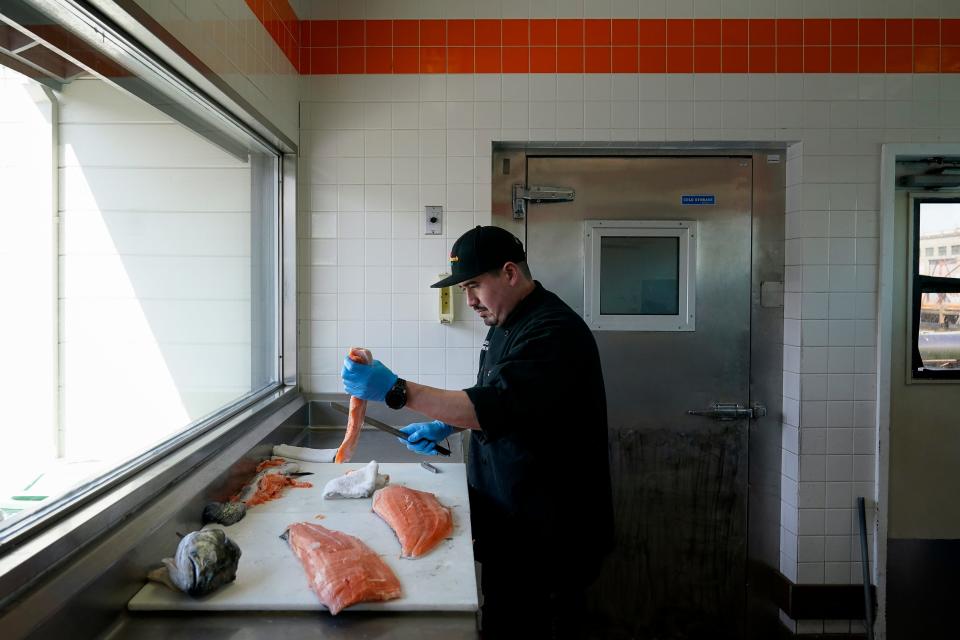West Coast king salmon are so depleted officials just canceled the Oregon and California season
SAN FRANCISCO – Chinook salmon stocks along the West Coast are so low fishery managers have officially canceled both the commercial and most of the recreational fishing season from northern Oregon to the California-Mexico border.
Salmon once filled West Coast rivers and streams so full local Native American tribes said their ancestors could walk across salmon-filled streams without sinking into the water.
Damming, overfishing, habitat destruction and climate change mean what's left of those once magnificent runs are only remnants.
Today, fewer than 167,767 adult fall chinook salmon are expected to try to return to the Sacramento River – the lowest since 2008. In the northern part of the state, just over 103,000 salmon are expected to return to the Klamath River. That's the second-lowest forecast since assessment methods began in 1997.
PREVIOUSLY: Feds close Chinook salmon season in California due to drought effects
On Thursday, the Pacific Fishery Management Council, the semi-federal body that oversees West Coast fisheries, recommended closing the state's chinook salmon season, the first time in about 15 years such a decision has been made.
Much of the Oregon season will be closed as well though some recreational salmon fishing will be allowed off the southern Oregon coast in the fall.
Chinook is also called "king" salmon because they're the largest of the Pacific salmon species.
The recommendations now got to the National Marine Fisheries Service for approval by May 16.
California Gov. Gavin Newsom requested a Federal Fishery Disaster Declaration to support the salmon fishing industry as it faces the closure.
Though the closure will affect tens of thousands of jobs, few are opposed to it. Many fishers say they want to take action now to guarantee healthy stocks in the future.
In March the state's chinook salmon season, which would have taken place along the California coast and northward to Cape Falcon, Oregon, through May 15, was canceled to protect fall chinook in the Sacramento River, according to the National Oceanic and Atmospheric Administration's National Marine Fisheries Service.
Chinook salmon along the coast of California and southern Oregon Coast continue to suffer lingering impacts from the region's mega-drought.
Drought heavily impacts salmon
Salmon, including chinook, California’s predominant species, rely on plentiful waters to hatch and travel from their spawning grounds to the ocean and then to migrate back again and drop the eggs that produce the next generation of fish.
Despite this winter's massive rains, water in California and much of the West has been anything but plentiful for years.
How many salmon make their way up rivers to spawn depends on their three-year life cycle from when eggs hatch in streams to when adults return from the ocean.
How does climate change affect you?: Subscribe to the weekly Climate Point newsletter
READ MORE: Latest climate change news from USA TODAY
Especially wet years mean more salmon hatching. Dry ones mean fewer three years later. Three years ago – in 2020 – California’s waters were in a particularly severe drought.
“This is a decadeslong trend, and the past few years of record drought only further stressed our salmon populations,” said Charlton H. Bonham, Director of the California Department of Fish and Wildlife.
Low river flows and high river water temperatures have affected the salmon's survival, especially as they emerge as eggs and need to go downstream to the ocean, said Robin Ehlke, salmon staff officer for the management council.
For the past couple of years, the models used to estimate fish populations have been performing poorly, thanks to the impacts of climate change and the drought, said sport fisherman Jim Yarnall, a member of the council’s salmon advisory subpanel of fishing and tribal representatives.
“The people running these models, they’re pulling their hair out. It’s an unfortunate place where we are and it’s going to impact a lot of livelihoods,” he said.
How are salmon fishing seasons set?
Seasons are set a year in advance, with the possibility of amendment.
NOAA Fisheries gives the management council and its advisory panel guidance on the numbers they expect to see.
State fisheries managers release abundance numbers.
The council knows it needs to get a set amount of salmon back out of the ocean and up the rivers to their spawning grounds to keep a healthy stock of salmon, Ehlke said.
The council and its advisory panels craft proposed seasons that meet the minimum goals.
A public hearing and comment period take place.
A final proposal is forwarded to NOAA Fisheries for review and approval.
Hope for the future
Yarnall remains optimistic about chinook in California.
“If there’s a silver lining in all of this, California has been wet here since December,” he said. “Snowpack is high. The reservoirs are filling and salmon are an amazingly resilient species.”
“If we get out of the way and given half a chance,” he said, “you can see them bouncing right back in three years to an abundant fish stock.”

Contributing: The Associated Press
This article originally appeared on USA TODAY: California and Oregon chinook salmon season canceled

